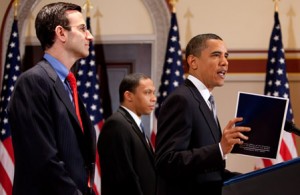Today the White House Office of Management and Budget (OMB) released the mid-session review to the House of Representatives. The latest update to the Administration’s economic forecast, last done in February, and its budget projections going out until 2019 shows a somewhat smaller federal 2009 deficit, but much larger subsequent deficits than previously projected.
It also shows two more years of 10% unemployment rates, and a -2.8% drop in the nation’s economy this year instead of the previously forecast growth.
Executive summary devoid of spin: the economy is in bad shape with no immediate relief in sight. This is bad news for the nation’s shrinking middle class, for the automobile business and our whole consumer-spending based economy.
“Overall, it underscores the dire fiscal situation that we inherited and the need for serious steps to put our nation back on a sustainable fiscal path,” said Peter R. Orszag, Director of the OMB.
The report is certain to be attacked by the Republican party whose popularity along with the Democrats continues to decrease as economic woes continue and jobs are being lost.
The Obama Administration now predicts that taxpayer expenses for financial system bailouts will be less than anticipated. In addition, an open item for a possible further financial stabilization program has been removed. The cost of the FDIC bank rescues have also been lowered.
The bottom — red-ink — line is a slight $262 billion improvement in the 2009 deficit, now projected to be whopping $1.58 trillion – or 11.2% of Gross Domestic Product – down from a previously projected $1.84 trillion or 12.9% of GDP.
The Administration claims that its economic projections now show that it “inherited a deeper recession than projected in February, which shouldn’t surprise anyone living outside of the artificial world of Washington.
Because of this Great Recession, spending programs including unemployment insurance and food stamps are projected to automatically increase, while revenues are projected to decline. So, here come higher medium-term deficits both directly and indirectly through higher interest costs on a higher level of public debt.
Over the next 10 years, the net effect is $2 trillion added to the projected deficit, compared to February’s economic assumptions. That brings the projected 10-year deficit for 2010-2019 to $9.05 trillion – in line with CBO’s June projection. Interest payments, which, to be fair are almost entirely represent the cost of the debt accumulated due to the tax cutting and spending policies of past administrations, as well as the need to use more deficit spending to help the economy recover from the worst downturn since the Great Depression, are 3.4% of GDP.
The report also claims that unpopular taxpayer financed bailouts also have “helped stabilize the American automobile industry, save jobs, and helped consumers access credit to purchase cars.”
Chrysler and General Motors, the automakers that received assistance through the Troubled Asset Relief Program (TARP), have restructured, and emerged from bankruptcy on June 10, 2009, and July 10, 2009. Both of their futures are uncertain as the auto market remains at the lowest levels in decades.
“The Government will continue to monitor its investment in these companies with the
goal of selling the Government investments in these firms as soon as practicable and recouping the investment made by taxpayers in these companies” the report claims.

